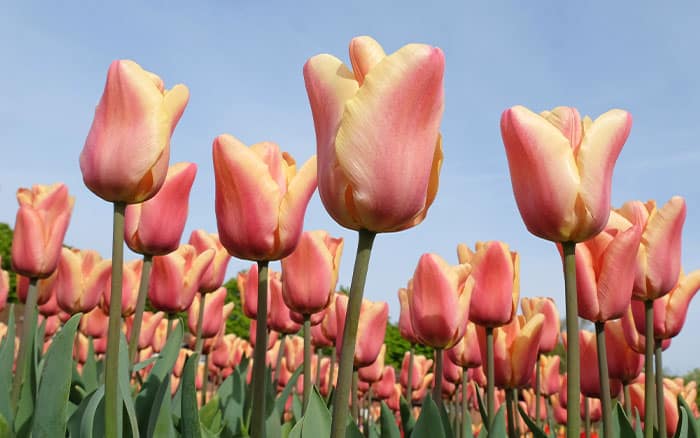November is a great time to plant tulip bulbs. And one of the main reasons why is that tulips can be susceptible to a disease called ‘Tulip Blight’. The spores of this disease generally don’t survive cold temperatures. So, planting tulip bulbs during the winter should greatly help overcome this potential problem.
It’s also a great time to buy tulip bulbs as many bulb companies are offering them at reduced prices. So, you can grab yourself a bargain whilst obtaining some wonderful, spring flowering beauties!
The choice can sometimes be overwhelming as there are more than three thousand different registered cultivars! As a result, tulips are divided into 15 different groups based on things like different flower shapes and flowering times. This is especially useful to know when deciding if you want your chosen tulips to flower all at the same time or at different times.
Group 1 – Single early
These tulips have relatively large, round flowers, short sturdy stems and generally flower mid-spring. Their relatively short stature makes them ideal choices for growing in containers.
Examples include ‘Apricot Beauty’ and ‘Christmas Dream’.

Group 2 – Double early

Double-flowered tulips in this group have long-lasting flowers with so many petals they look like peonies! They tend to flower a little later and are shorter than their single counterparts.
Examples are ‘The Foxtrot’, ‘Orca’ and ‘Abba’.
Group 3 – Triumph
A widely variable group of mid-season flowering tulips ranging from long slightly flared petal cultivars to short, rounded flowers. All tend to have strong, upright stems.
Examples are ‘Dynasty’, ‘Alibi’ and ‘Negrita’.

Group 4 – Darwin hybrids

These are mid-season flowering giants both in terms of height and size of their pyramid-shaped buds. They make good long-lasting cut flowers and are best grown massed together in a flower bed due to their size.
Examples are ‘Beauty of Spring’, ‘Daydream’ and ‘Parade’.
Group 5 – Single late
These are also tall tulips but with shorter, more elegantly shaped flowers than the Darwin Hybrids. Of which one of the most well-known cultivars is ‘Queen of Night’.
Other examples are ‘Sorbet’ and ‘Violet Beauty’.

Group 6 – Lily-flowered

Lily-flowered tulips flower mid-to-late spring and have distinctive, lily-shaped, and beautifully flared petals held on narrow stems that sway gracefully.
Examples are ‘White triumphator’, ‘Mariette’ and ‘Fly Away’.
Group 7 – Fringed
The distinctive fringing on the flower petals of tulips placed in this group is caused by cell mutation on bulbs in many of the different groups. As a result, the stem sizes, flower shape and flowering times of the various cultivars in this group vary widely.
Examples are ‘Santander’, ‘Swan Wings’ and ‘Bell Song’.

Group 8 – Viridiflora

‘Viridiflora’ means green-flowered and green is the common theme amongst tulips in this group. Whether it be the green buds of the emerging flowers or green streaks running the length of the flower petals. Flower shapes vary widely from single, double and lily to parrot-shaped on flower stems ranging from short to tall.
Examples are ‘The Artist’, ‘Spring Green’ and ‘Formosa’.
Group 9 – Rembrandt
This group is made up of vividly coloured and striped tulips resembling historic tulips of the eighteenth century. Their petals can be both feathered in texture and flamed in colour ways. They are available in several flower shapes and sizes, with flowering times ranging from early spring to late season.
Examples are ‘Rem’s Favourite’ and ‘Helmar’.

Group 10 – Parrot

These are a group of very flamboyant tulips! Their single-petalled flowers are extremely curled, ruffled or elaborately cut and are available in a range of colours and patterns. They flower late season on tall stems.
Examples are ‘Caribbean Parrot’, ‘Rococo’ and ‘Flaming Parrot’.
Group 11 – Double late
The flowers on this group of tulips are exceptionally showy, often with numerous, frilly petals and large, round flower heads flowering on tall stems.
Examples are ‘Morris Gudanov’, ‘Black hero’, and ‘Cretaceous’.

Group 12 – Kaufmanniana

Petite in size and with flower shapes resembling water lilies. These early flowering tulips can be distinguished by their mottled leaves and bi-coloured flowers as well as their diminutive size.
Examples are ‘Giuseppe Verdi’ and ‘Heart’s Delight’.
Group 13 – Fosteriana
Early flowering tulips in striking single colours, with broad leaves and unusually large flowers. Also known as Emperor tulips one of the most famous examples is ‘Red Emperor’.

Group 14 – Greigii

Another group of early flowering, petite tulips, is distinguishable by their relatively large flowers. These appear on short, sturdy stems and mottled or striped leaves that spread close to the ground.
Examples are ‘Casa Grande’, ‘Toronto’ and ‘Fire of Love’.
Group 15 – Miscellaneous
All other cultivars and types that do not fit into the above 14 categories such as ‘Peppermintstick’.

Tulips are often treated as annuals due to many not flowering as freely the following year. But there are some that are reliably perennial and a few that are delightfully scented.
Examples of these are as follows:
Reliably perennial
Species tulips, such as those listed in Groups 12 and 14 below and their hybrids. These are generally short with small flowers needing good drainage. They are therefore best planted in raised beds, rockeries or gravel gardens.
For a taller, reliably perennial group of tulips, choose from those listed as Viridiflora in Group 8 above such as ‘The Artist’.
The Darwin Hybrids forming Group 4 are also reliably perennial.
Delightfully scented
For some fantastically scented tulips, I highly recommend both ‘Ballerina’ and ‘Brown Sugar’.

Whatever the size of your available planting space and preferred colour and flower shape, one thing’s for sure. There’s almost certainly a tulip that you’ll fall in love with. So why not take advantage of the cut-price bulbs currently on offer and plant some this month?

Leave A Comment